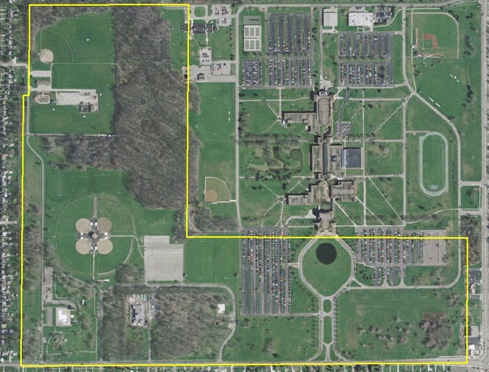
History
The former Nike Missile Site CL-59 is a formerly used defense site located in Parma Heights, Cuyahoga County, Ohio. It served as a Nike defense installation for northeast Ohio from 1958 until 1961.
The site was comprised of two major areas, the Control Area and Launch Area. Currently, the former Control Area is the Nathan Hale Park, a public park on Sesquicentennial Park Road, and the former Launch Area is located at the entrance of Cuyahoga Community College’s Western Campus along West Pleasant Valley Road.
Congress established the Defense Environmental Restoration Program/Formerly Used Defense Site (DERP/FUDS) program to clean up properties that were under the jurisdiction of the Secretary and owned, leased, or possessed by the United States and transferred from Department of Defense (DoD) control prior to Oct. 17, 1986. (The term “Secretary” means the Secretary of Defense and the Secretaries of each of the military departments, as well as the Secretaries of any predecessor departments or agencies of DoD). The U.S. Army Corps of Engineers (USACE) manages the FUDS program.
Major Milestones/Accomplishments
Environmental response actions at DERP/FUDS conform to the requirements of the Comprehensive Environmental Response, Compensation and Liability Act (CERCLA) and the National Oil and Hazardous Substances Pollution Contingency Plan (NCP).
- Two underground storage tanks were removed from the Control Area in 2000. A 5,000-gallon tank used for gasoline storage was removed from under a parking lot, and a 6,000-gallon tank containing diesel fuel was removed from under a soccer field. The tanks were removed and closed in accordance with the State of Ohio Bureau of Underground Storage Tank Regulations (BUSTR). Confirmation samples of the soil at both locations showed no evidence of contamination.
- A Preliminary Assessment (PA) covering both the Launch and Control areas was completed in 2002. As part of the PA, analysis of historic aerial photographs (covering the period from 1952 through 1994) was performed. The PA did not find any evidence of contamination at the Control Area.
- A Site Inspection (SI) covering the Launch Area was completed in 2002. The findings of the PA relating to the Launch Area were used in determining the sampling locations and analytical tests for the SI. During the SI, eight surface and 22 subsurface soil samples were collected, as well as one screening groundwater sample. A variety of organic compounds, primarily polynuclear aromatic hydrocarbons (PAHs) and two metals (arsenic and iron) were detected and subsequently compared to U.S. Environmental Protection Agency (EPA) Region 9 residential soil and tap water preliminary remediation goals. Based on the results, it was decided that further investigation and/or assessment was warranted.
- A Focused Site Inspection (FSI) of the Launch Area was completed in 2007. The FSI was conducted to determine if PAHs and metals detected during the SI were related to former activities at Nike site or were present area-wide. Twelve surface soil samples were collected for analysis of geotechnical and chemical characteristics relating to contaminant transport and availability, as well as PAHs and metals. One off-site and two on-site groundwater monitoring wells were installed and sampled in order to assess groundwater quality.
- The data collected showed arsenic and PAH constituents at concentrations that merited evaluation. PAHs are commonly found throughout the country, and the results of the FSI indicated that the PAHs may not have originated from Nike operations. The arsenic concentrations were similar to those found in background concentrations in Ohio and other Midwestern states. There was no evidence that the Nike operations caused contamination. Minerals in the soil could account for the arsenic concentrations, and combustion of fossil fuels and ordinary motor vehicle operations could account for the PAH concentrations.
- A baseline human health risk assessment (HHRA) was completed in 2009 to evaluate potential risks and hazards from current and predicted future exposures to contaminated media at the Launch Area. The HHRA concluded that the former Nike Missile Site CL-59 does not pose any human health concerns.